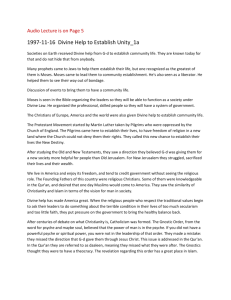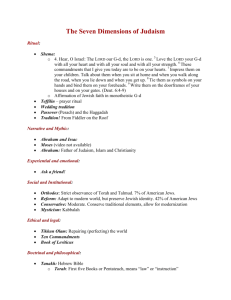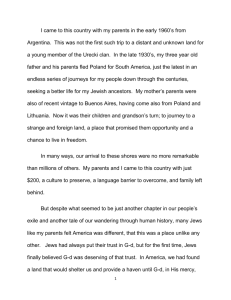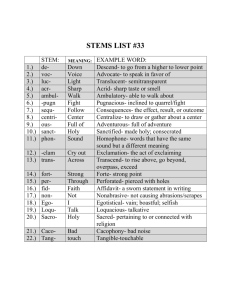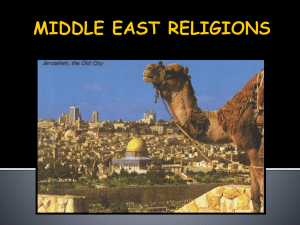Acharei H"B Parshah Acharei
advertisement
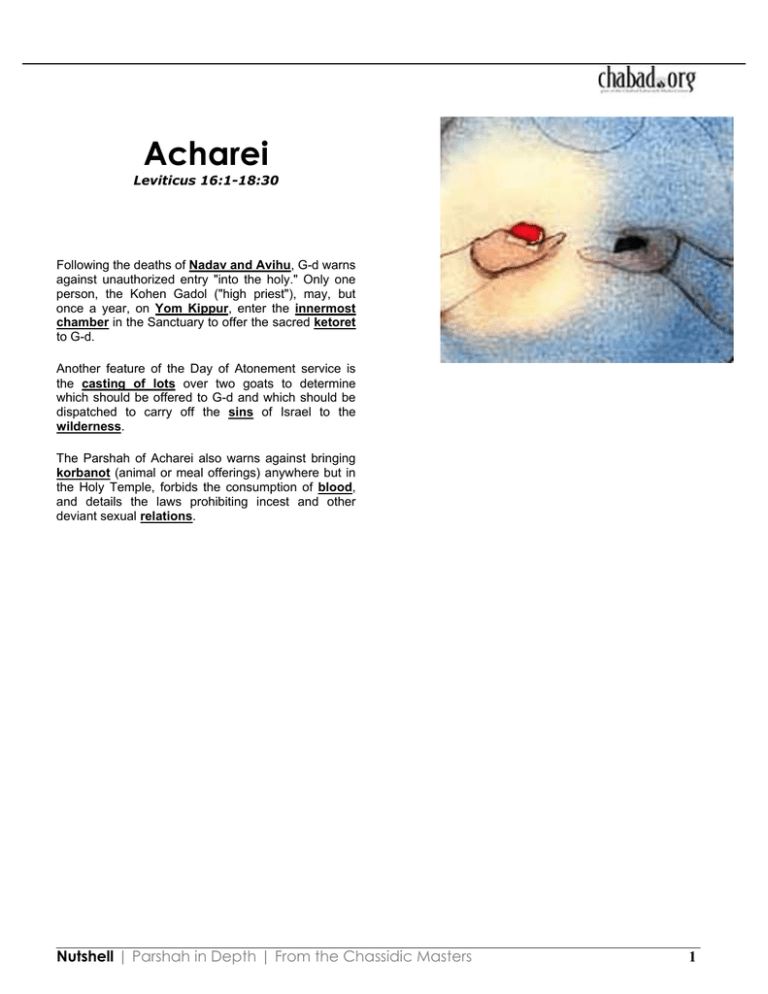
Parshah Acharei H"B In a Nutshell Acharei Leviticus 16:1-18:30 Following the deaths of Nadav and Avihu, G-d warns against unauthorized entry "into the holy." Only one person, the Kohen Gadol ("high priest"), may, but once a year, on Yom Kippur, enter the innermost chamber in the Sanctuary to offer the sacred ketoret to G-d. Another feature of the Day of Atonement service is the casting of lots over two goats to determine which should be offered to G-d and which should be dispatched to carry off the sins of Israel to the wilderness. The Parshah of Acharei also warns against bringing korbanot (animal or meal offerings) anywhere but in the Holy Temple, forbids the consumption of blood, and details the laws prohibiting incest and other deviant sexual relations. Nutshell | Parshah in Depth | From the Chassidic Masters 1 B”H Acharei Summary and Commentary www.Chabad.org Acharei He shall take a pan-full of fiery coals from atop the altar that is before G-d, and the fill of his hands of finely-ground ketoret (incense), and bring them inside the Parochet. Leviticus 16:1—18:30 Following the deaths of Nadav and Avihu, who "came close to G-d and died", G-d tells Moses to instruct Aaron ...that he should not enter, at all times, into the holy, inside the Parochet (the "veil" that separated the "Holy of Holies" from the rest of the Sanctuary), before the Kaporet (cover) that is upon the Ark--lest he die; for in a cloud I appear above the Kaporet... Only on the holiest day of the year--Yom Kippur--and after bringing a series of specially ordained offerings, should the Kohen Gadol ("high priest") purify himself, put on white linen garments, and enter the chamber housing the Ark: Commentary And he shall place the ketoret upon the fire before G-d; and the cloud of incense shall cover up the Kaporet that is on [the Ark of] the Testament... Our Parshah then goes on to detail the service performed by the Kohen Gadol on Yom Kippur to secure atonement for his people. Among the offerings of the day were two male goats: And Aaron shall cast lots upon the two goats: one lot for G-d, and one lot for Azazel. The goat that which the lot determined to be "For G-d" is brought as an offering and its blood is sprinkled in the Holy of Holies. The one deemed for "Azazel" is "dispatched by the hand of an appointed man into the wilderness; and the goat shall bear upon it all their sins to a barren land." Following: After the death of the two sons of Aaron (Leviticus 16:1) Rabbi Elazar ben Azaria would explain this with a parable: A sick person was visited by a physician, who said to him: "Do not eat cold food and do not lie in the damp, lest you die." There then came a second physician who said to him: "Do not eat cold food and do not lie in the damp, lest you die as so-and-so died." The second one influences him more than the first. Thus it says: "After the death of the two sons of Aaron." (Rashi) And he shall make atonement for the holy place, over the defilements of the children of Israel, over their transgressions in all their sins. And so shall he do for the Tent of eting, which dwells amongst them in the midst of their defilement ... Commentary came close: Who came close to G-d and died (16:1) They approached the supernal light out of their great love of the Holy, and thereby died. Thus they died by "divine kiss" such as experienced by the perfectly righteous; it is only that the righteous die when the divine kiss approaches them, while they died by their approaching it... Although they sensed their own demise, this did not prevent them from drawing near to G-d in attachment, delight, delectability, fellowship, love, kiss and sweetness, to the point that their souls ceased from them. the Kohen Gadol throughout the year). 2) The special services of the day (reciting the confession over the Yom Kippur offerings, casting the lots, entering the Holy of Holies to offer the ketoret and to sprinkle the blood of the Yom Kippur offerings)--performed in the linen garments. 3) The two rams brought as "ascending offerings" and the day's musaf offerings--in the golden garments. 4) returning to the Holy of Holies to remove the pan of burning incense--in linen garments. 5) the regular afternoon services--in the golden garments. (Talmud, tractate Yoma) (Ohr HaChaim) cast lots: Two he-goats (16:5) white linen garments,: And he shall bathe his flesh in water, and clothe himself in them (16:4) They should be identical in appearance, height and price, and should be acquired together. (Talmud, Yoma 62b) On that day, the Kohen Gadol immersed (in a mikvah) five times, and washed his hands and feet from the kiyyor ("basin") that stood before the Sanctuary ten times: each time he changed his clothes, he was required to immerse once, and wash twice (once before removing the first set of clothes, and again after dressing in the second set). dwells: And so shall he do for the Tent of Meeting, which dwells amongst them in the midst of their defilement (16:16) For there were five sets of services performed by him on that day: 1) The regular morning services, performed in the "golden garments" (worn by Also when they are in a state of defilement, the Shechinah (Divine Presence) dwells with them. (Talmud; Rashi) Nutshell | Parshah in Depth | From the Chassidic Masters 2 Acharei Summary and Commentary B”H www.Chabad.org And this shall be an everlasting statute for you: in the seventh month, on the tenth day of the month, you shall afflict your souls, and do no work at all, the home born or the stranger that sojourns among you. For on this day will He will atone for you, to cleanse you, that you may be clean from all your sins before G-d... once a year. The Parshah of Acharei also warns against bringing offerings to G-d anywhere but in the Holy Temple, forbids the consumption of blood, and details the laws prohibiting incest and other deviant sexual behaviors. Commentary this day: "For on this day, He shall atone for you (16:30) On Yom Kippur, the day itself atones... as it is written, For on this day... shall atone for you." (Maimonides) Nutshell | Parshah in Depth | From the Chassidic Masters 3 B”H Acharei From the Chassidic Masters Withdrawal and Return Based on the teachings of the Lubavitcher Rebbe, Rabbi Menachem M. Schneersohn 1. The Death of Nadav and Avihu Our Parshah begins with the verse: "And the L-rd spoke to Moses, after the death of the two sons of Aaron, when they drew near to the L-rd and they died" (as related in Leviticus 10, in the Parshah of Shmini). The final words, however present a difficulty. Why does the Torah add "and they died" when it has already said, "after the death of the two sons of Aaron?" The Midrash, in giving an explanation of their death, cites the following explanations: They entered the Holy of Holies; they did not wear the priestly garments necessary for their service; they did not have children; and they did not marry. Our second question now arises: What is the source of the Midrashic account? Where, in the Torah, are these four faults alluded to? Further: How can we suppose that Aaron's two sons, Nadav and Avihu, were guilty of sin? The Midrash relates (based on Leviticus 10:3) that Moses said to Aaron, "Aaron, my brother, I knew that the Sanctuary would be sanctified by those who were beloved and close to G-d. Now I see that they -- Nadav and Avihu -- are greater than both of us." If this was so, how could they have sinned? 2. A Fatal Ecstasy There is a Chassidic explanation that Aaron's two sons did not "sin" literally. Their "sin" was to allow their desire to cleave to G-d to mount to such an intensity that they died. Their bodies could no longer contain their souls. Thus the Torah says "when they drew near to the L-rd (with such passion that) they died." And this was counted as a sin! For although a Jew must divest himself of material concerns, at the moment when he stands poised at the ultimate ecstasy of the soul, he must turn again to the work that the soul must do within a physical existence. It is written in the Ethics of the Fathers (4:22): "Against your will you live." Set against the desire of the soul to rise beyond the world, is its task of creating a dwelling-place for G-d within the world. Nadav and Avihu achieved the ecstasy but not the www.Chabad.org return. This was their sin and the reason for their death. They "drew near to the L-rd and they died." They allowed their spiritual passion override their thisworldly task. They went beyond the world and beyond life itself. This act lies at the heart of each of the four faults which the Midrash ascribes to them. They "entered the Holy of Holies," the innermost reaches of the spirit, without thinking of their return to the outer world. They "did not wear the (priestly) garments." Their concern was to divest themselves of the world and to become purely spiritual. They forsook the necessary "garments" in which the word of G-d is clothed, the Mitzvot, the physical actions that sanctify a physical environment. They "had no children" and "did not marry." That is, they did not fulfill G-d's command to "be fruitful and multiply" and to bring new souls into the world. They did the opposite. They withdrew their own souls from the world. All their faults stemmed from a single misconception: that the Jew draws close to G-d by withdrawal instead of involvement. In fact, both are necessary. And that is why, at the point of the year when we are most powerfully taken out of the world -- Yom Kippur -- we begin the reading of the Torah from these verses, as a reminder of our ultimate task. 3. Entrance and Exit Rashi explains that the command, "that he (Aaron) come not at all times into the holy place . . . (but) with this shall Aaron come into the holy place," comes immediately after the statement of the death of his sons, to warn that his (and our) service of G-d should not be like that of Nadav and Avihu. A question arises here. Can we really demand of a person at the point of ecstasy, that he return to his mundane role? If his experience is genuine, if he has reached the love of G-d "with all your might" and has broken through all barriers of separation between man and G-d, can he hold himself back at the very point of union, and re-immerse himself in all the constraints of the human situation? Is there not an emotional incompatibility between the absolute abandonment of a person to G-d and a constant vigilance not to go too far? Nutshell | Parshah in Depth | From the Chassidic Masters 4 B”H Acharei From the Chassidic Masters The answer lies in how a person begins his spiritual journey. If he sets out with the intention of satisfying his own desires, however exalted they are, he will not wish to turn back from his private ecstasy to the needs of the world. But if he sets out in obedience to G-d's command, knowing that though "You shall love the L-rd your G-d . . . with all your might," nonetheless "He created (the world) not to be empty, he formed it to be inhabited" (Isaiah 45:18), then within his ecstatic approach to G-d, the desire ultimately to return and sanctify the world will always be implicit. There is a famous story in the Talmud. Four men entered the "Grove" (the mystical secrets of the Torah): Ben Azzai, Ben Zoma, Acher and Rabbi Akiva. Ben Azzai looked and died. Ben Zoma looked and was stricken (with madness). Acher mutilated the shoots (i.e., became an apostate). Rabbi Akiva "entered in peace and came out in peace." On the face of it, the important difference between Rabbi Akiva and the other three was in how he came out of the "Grove." Why does the Talmud emphasize that he "entered in peace?" But the truth is that how each of the four entered, determined how they emerged. Ben Azzai entered seeking ecstasy, not return; therefore he "looked and died." (It is interesting to note that his Divine service was generally characterized by aspects of withdrawal -- see Talmud, Yevamot, 63b; Sotah, 4b. Cf. Shulchan Aruch Harav, Hilchot Talmud Torah, beg. ch. 3, in Kuntres Acharon..) But Rabbi Akiva entered "in peace," in obedience to the Divine will and seeking to unite the higher and lower worlds. That is why he came out in peace. His intention of returning was implicit at the outset of his path to religious ecstasy. This, too, was how Aaron was to enter the Holy of Holies, in fear, obedience and self-abnegation. And in this way he was able to "make atonement for himself and for his house" and to say a prayer for the sustenance of Israel, each of them acts of concern for the world. 4. Experience Into Action www.Chabad.org But every Jew is sometimes awakened to an intense religious experience, especially on Shabbat and the Festivals, more particularly during the Ten Days of Repentance, and above all on Yom Kippur. He is for a while taken out of his daily routine, his normal anxieties, and inwardly rises beyond his usual mental confines. It is at these times that he must remember that whatever he experiences when he enters this holy domain must be carried with him when he returns to his everyday world. He must not seek ecstasy for its own sake, but for the sake of the subsequent return. A religious experience must not be left as a memory; it must remain active in animating the whole of his life. Like Rabbi Akiva, he must enter and come out "in peace," that is, bringing G-d and the world closer together in harmony. 5. The Blessing of G-d This connection between the manner of entering and of leaving the realm of holiness, applies not only to the service of the Jew, but also to the material world itself. For all the Jew's needs, material as well as spiritual, come to him directly from G-d: "If you walk in My statutes and keep My commandments and do them, then I will give you rain in due season, and the land shall yield her produce..." (Leviticus 26:3-4). Only through his bond with G-d does the Jew receive his material needs. He who says "It will be well with me for I will walk in the stubbornness of my heart" is always in the last analysis proved mistaken. And this is intimated in our Parshah, describing the procedure of the High Priest's service. It was only after he had entered the Holy of Holies that he was able to pray for and secure the sustenance of the people. So it is that the public world that the Jew inhabits, and the private world of his religious experience, are intrinsically related. For if he draws his experience into the world, the world is thereby sanctified by man and blessed by G-d. From Torah Studies (Kehot 1986), an adaptation of the Lubavitcher Rebbe's talks by Britain's Chief Rabbi, Dr.Jonathan Sacks All the Torah's narratives have a teaching which is applicable to every Jew, not simply to the outstanding few. What, then, is the universal significance of the story of Nadav and Avihu? Surely not everyone can reach a level of ecstasy where one's life is in danger. A few need the warning; but what of the many? Nutshell | Parshah in Depth | From the Chassidic Masters 5 B”H Acharei From the Chassidic Masters www.Chabad.org Ketoret day, each morning and afternoon, to lend a pleasing fragrance to [the Holy Temple] and to the garments of those who served in it. Based on the teachings of the Lubavitcher Rebbe, Rabbi Menachem M. Schneersohn But Maimonides' words carry a significance that extends beyond their superficial sense. In the words of Rabbeinu Bechayei, G-d forbid that the great principle and mystery of the ketoret should be reduced to this mundane purpose. And he shall take a burning coals from the fill of his hands of ketoret; and he shall inside the curtain. censer-full of altar, and the finely-ground bring [these] And he shall place the ketoret upon the fire before G-d; and the cloud of the incense shall envelop the covering of the [Ark of] Testimony Leviticus 16:12-13 Man's quest to serve his Creator is perpetual and allconsuming, and can be pursued by all people, at all times, and in all places. There was one event, however, that represented the apogee in the human effort to come close to G-d--an event that brought together the holiest day of the year, the holiest human being on earth, and the holiest place in the universe: on Yom Kippur the Kohen Gadol (High Priest) would enter the innermost chamber of the Holy Temple in Jerusalem, the Holy of Holies, to offer ketoret to G-d. The offering of the ketoret was the most prestigious and sacred of the services in the Holy Temple. The ketoret was a special blend of eleven herbs and balms whose precise ingredients and manner of preparation were commanded by G-d to Moses. Twice a day, ketoret was burned on the golden altar that stood in the Temple. On Yom Kippur, in addition to the regular ketoret offerings, the Kohen Gadol would enter the Holy of Holies with a pan of smoldering coals in his right hand and a ladle filled with ketoret in his left; there, he would scoop the ketoret into his hands, place it over the coals, wait for the chamber to fill with the fragrant smoke of the burning incense, and swiftly back out of the room. The moment marked the climax of the Yom Kippur service in the Holy Temple. Maimonides describes the function of the ketoret as the vanquishing of the unpleasant odors that might otherwise have pervaded the Holy Temple. Since many animals were slaughtered in the sacred place each day, their flesh butchered and burnt and their intestines cleaned, its smell would doubtless have been like the smell of a slaughterhouse.... Therefore G-d commanded that the ketoret be burned twice a Chassidic teaching explains that the animal sacrifices offered in the Holy Temple represent the person's offering of his own animal soul to G-d--the subjugation of his natural instincts and desires to the divine will. This is the deeper significance of the foul odor emitted by the sacrifices which the ketoret came to dispel: the animal soul of man, which is the basic drive, common to every living creature, for selfpreservation and self-enhancement, possesses many positive traits which can be directed toward gainful and holy ends; but it is also the source of many negative and destructive traits. When a person brings his animal self to the Temple of G-d and offers what is best and finest in it upon the altar, there is still the foul odor--the selfishness, the brutality and the materiality of the animal in man--that accompanies the process. Hence the burning of the ketoret, which possessed the unique capability to sublimate the evil odor of the animal soul within its heavenly fragrance. Essence and Utility This, however, still does not define the essence of the ketoret. For if the more external parts of the Temple might be susceptible to the foul odor emitted by the animal souls offered there, the Holy of Holies was a sanctum of unadulterated holiness and perfection; no animal sacrifices were offered there, for this part of the Temple was exclusively devoted to sheltering the Ark of Testament that held the tablets upon which Gd had inscribed the Ten Commandments. If the garments (i.e., character and behavior) of the ordinary priest might be affected by the negative smell of the slaughtered beasts he handled, this was certainly not the case with the Kohen Gadol, the greatest of his brethren in the fraternity of divine service. If every day of the year the scent of evil hovers at the periphery of even the most positive endeavor, Yom Kippur is a day in which there is no license for the forces of evil to incriminate. If the ketoret was offered by the Kohen Gadol in the Holy of Holies on Yom Kippur, its ultimate function could not be the sublimation of evil. The sublimation of evil is something that only the ketoret can achieve, but this is not the sum of its Nutshell | Parshah in Depth | From the Chassidic Masters 6 B”H Acharei From the Chassidic Masters purpose and function. The word ketoret means bonding; the essence of the ketoret is the pristine yearning of the soul of man to cleave to G-d--a yearning that emanates from the innermost sanctum of the soul and is thus free of all constraints and restraints, of all that inhibits and limits us when we relate to something with the more external elements of our being. Its purity and perfection are what give the ketoret the power to sweeten the foulest of odors, but dealing with evil is not what it is all about. On the contrary, its highest expression is in the utterly evil-free environment of the Holy of Holies on Yom Kippur. Bringing the Past in Line Today, the Holy Temple no longer stands in Jerusalem, and the Kohen Gadol enters the Holy of Holies only in our recitation of the account of the Yom Kippur Temple service in the prayers of the Holy Day and in our vision of a future Yom Kippur in the rebuilt Temple. But the ketoret remains a basic component of our service of G-d in general, and of our observance of Yom Kippur in particular. We are speaking, of course, of the spiritual ketoret, which exists within the human soul as the power of teshuvah. Like the incense that burned in the Holy Temple, the manifest function of teshuvah is to deal with negative and undesirable things. On the day-to-day, practical level, teshuvah is repentance--a response to wrongdoing, a healing potion for the ills of the soul. But teshuvah is also the dominant quality of Yom Kippur, the holiest day of the year. Obviously, there is more to teshuvah than the rectification of sin. www.Chabad.org true self come to light, while his previous, corrupted self was but an external distortion of his true being. Only teshuvah has such power over the past; only teshuvah can undo a negative deed. But this is only one of the uses of the power of return. Teshuvah is not only for sinners, but also for the holiest person in the holiest time and the holiest place. For even the perfectly righteous individual needs to be liberated from the limitations of the past. Even the perfectly righteous individual is limited-limited because of knowledge not yet acquired, insights still ungained, feelings yet to be developed, attainments still unachieved; in a word, limited by time itself and the tyranny of its one way only law. As we advance through life, we conquer these limits, gaining wisdom and experience and refining and perfecting our character. But is our ability to grow and achieve limited to the future only? Is the past a closed frontier? When we adopt the inward-seeking approach of teshuvah in everything we do, we need not leave an imperfect past behind at the waysides of our lives. In a teshuvah state, when we learn something new, we uncover the deeper dimension of our self which was always aware of this truth; when we refine a new facet of our personality, we bring to light the timeless perfection of our soul. Never satisfied in merely moving forward, our search for our own true self remakes the past as well. Based on the teachings of the Lubavitcher Rebbe; adapted by Yanki Tauber The word teshuvah means return: return to pristine beginnings, return to the intrinsic perfection of the soul. For the essence of the soul of man, which is a spark of G-dliness, is immune to corruption. The inner self of man remains uninvolved in the follies of the ego, untouched by the outer self's enmeshment in the material and the mundane. Teshuvah is the return to one's true self, the cutting through of all those outer layers of misguided actions and distorted priorities to awaken one's true will and desire. This explains how teshuvah achieves atonement for past sins. Teshuvah enables the sinner to reconnect with his own inherent goodness, with that part of himself which never sinned in the first place. In a sense, he has now acquired a new self, one with an unblemished past; but this new self is really his own Nutshell | Parshah in Depth | From the Chassidic Masters 7
